 Two great families buried in the Jewish Waldheim Cemetery at Forest Park changed Chicago entertainment forever.
Two great families buried in the Jewish Waldheim Cemetery at Forest Park changed Chicago entertainment forever.
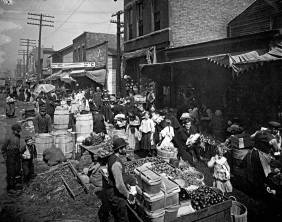 Israel Balaban (1862-1931) a Jewish immigrant arrived in Chicago in 1882 from Odessa Russia along with his wife Augusta “Goldie” Manderbursky (1868-1936). They opened a grocery store and fish shop on Chicago’s famous Maxwell Street. They and their five sons and daughter lived in the back of the store.
Israel Balaban (1862-1931) a Jewish immigrant arrived in Chicago in 1882 from Odessa Russia along with his wife Augusta “Goldie” Manderbursky (1868-1936). They opened a grocery store and fish shop on Chicago’s famous Maxwell Street. They and their five sons and daughter lived in the back of the store.
By 1910 the family had moved to the west side where two of their five sons, Barney Balaban (1887-1971) the oldest son, and A. J. Balaban (1889-1962) along with partners Sam Katz (1892-1961) and Sam’s father Morris Katz (1869 -1939) became the genius behind the Balaban and Katz chain of palatial “movie palaces “. These wonderful theatres shaped how almost every one of us and our parents sought entertainment and viewed the Hollywood movies.
They began in 1908 by leasing the 100-seat Kedzie Nickelodeon at 3204 W Roosevelt Road. This modest place simply had folding chairs but introduced movies paired with live entertainment. In the early years, A.J. (Abe) would take tickets and perform, sister Ida would sing. Brother John played music a phonograph to attract customers out on the street..
 18 months later, In September of 1909, they opened the 600 seat Circle theatre, complete with a balcony at 3241 W. Roosevelt. Then came the Central Park Theatre at 3535 W. Roosevelt with 1780 seats. With their success, the family soon moved into a fine residence on facing Lake Michigan, a far cry from their Maxwell Street start.
18 months later, In September of 1909, they opened the 600 seat Circle theatre, complete with a balcony at 3241 W. Roosevelt. Then came the Central Park Theatre at 3535 W. Roosevelt with 1780 seats. With their success, the family soon moved into a fine residence on facing Lake Michigan, a far cry from their Maxwell Street start.
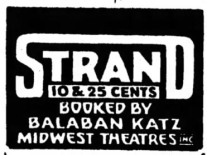
The Balaban and Katz theatre chain was born and grew quickly. By 1924, with five theatres opened they had over 12 million patrons and $5 million in ticket sales. At their peak The Balaban and Katz families opened or operated almost a hundred elegant theaters in the Midwest.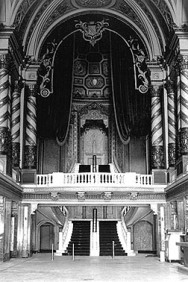 These were incredibly ornate theaters, such as the Chicago Theatre on State Street, the Uptown Theatre at Lawrence and Broadway, and the Congress Theaters, filled with fine furnishings, antiques, and artwork.
These were incredibly ornate theaters, such as the Chicago Theatre on State Street, the Uptown Theatre at Lawrence and Broadway, and the Congress Theaters, filled with fine furnishings, antiques, and artwork.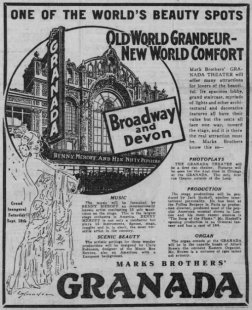
In the years that followed, there were more than 85,000 seats in 50 Chicago-area theaters built and/or operated by the Balaban and Katz company There were 11 theatres with more than 3,000 seats each, totaling over 37,000 seats . They were the Marbro 4124 W. Madison; the Paradise, 231 n Pulaski; Tivoli 6329 Cottage Grove; the Granada, 6427 N. Sheridan; Belmont 1632 Belmont; Southtown 610 W. 63rd St.; Senate, 3128 W. Madison; Norshore, 1748 N. Howard; and the Tower 1510 E. 63rd St. ; Oriental 20 W. Randolph St.; The Chicago 175 N. State St. The Uptown Theatre in a north side neighborhood became the crown jewel of the Balaban and Katz theatre chain with an astounding 4314 seats. Sadly, only a few of these gorgeous theaters still stand today.

The biggest and best theaters in Chicago were designed by architects, George Leslie Rapp (1878–1941) and his brother Cornelius Ward Rapp (1861-1926). The firm was well known as one of the leading designers of early 20th century movie palaces. They designed over 400 theatres across the country,
.Many of their theatres were known for exciting and lavish stage shows, which evolved from vaudeville. Barney Balaban perfected the concept of live shows and movies continuously running from 9:30 in the morning until late into the night. Just a few of the stars who appeared in the live shows included Bob Hope, Jackie Gleason and Art Carney, The Marx Bros. Louis Armstrong, Sophie Tucker, Ginger Rogers, Benny Goodman, organist Jesse Crawford, and the orchestras of Paul Whiteman and John Philip Sousa, and so many more. 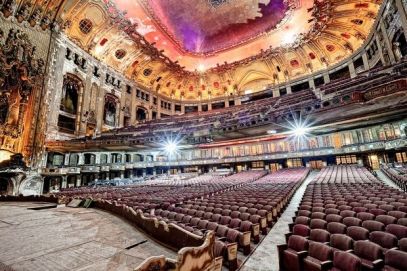 Balaban & Katz were the first to offer air conditioning in its theaters inviting Chicagoans into a cool place to escape during hot summers. Balaban & Katz became a subsidiary of United Paramount Theatres, Inc.in 1948 after Paramount was forced to sell off its theaters.
Balaban & Katz were the first to offer air conditioning in its theaters inviting Chicagoans into a cool place to escape during hot summers. Balaban & Katz became a subsidiary of United Paramount Theatres, Inc.in 1948 after Paramount was forced to sell off its theaters.
 If that were not enough success, they also became pioneers in Chicago television receiving a license in 1946 for only the sixth TV station in the United States. WBKB ( Balaban and Katz Broadcasting) later became today’s CBS station on Channel 2. The station aired some of the earliest programming including Junior Jamboree which later became Kukla, Fran and Ollie on NBC
If that were not enough success, they also became pioneers in Chicago television receiving a license in 1946 for only the sixth TV station in the United States. WBKB ( Balaban and Katz Broadcasting) later became today’s CBS station on Channel 2. The station aired some of the earliest programming including Junior Jamboree which later became Kukla, Fran and Ollie on NBC
So we honor both Balaban and Katz families who were so successful at entertaining Chicago. Most if not all are at rest in Jewish Waldheim Cemetery in Forest Park, why they are the subject of this cemetery blog.. 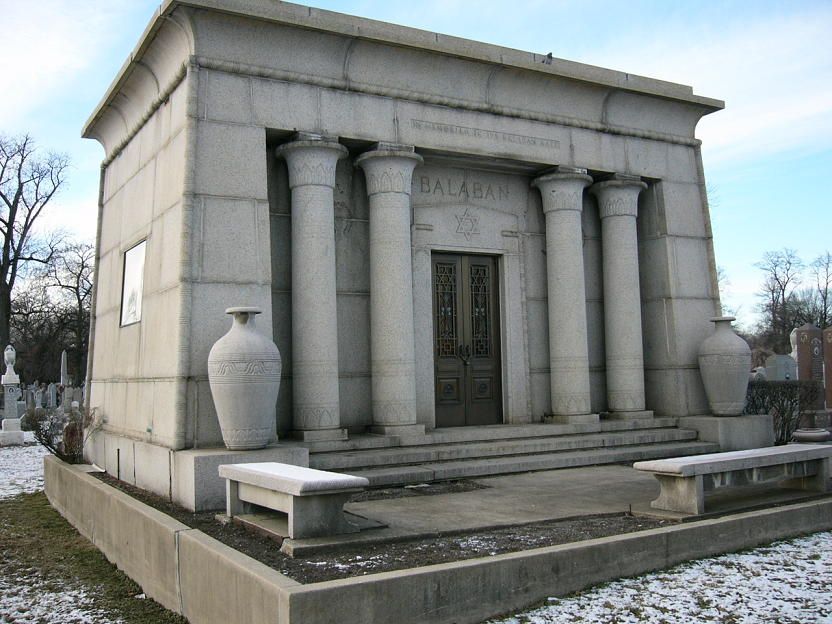 The Balaban family erected a mausoleum within Anshe Kanesses Israel No. 1 (Jewish Waldheim gate number 25) The concept of a mausoleum or structure for the dead began with King Mausolus, an ancient ruler who died 350 BC His widow built him a tomb at Halicarnassus in Southern Asia Minor now Turkey.
The Balaban family erected a mausoleum within Anshe Kanesses Israel No. 1 (Jewish Waldheim gate number 25) The concept of a mausoleum or structure for the dead began with King Mausolus, an ancient ruler who died 350 BC His widow built him a tomb at Halicarnassus in Southern Asia Minor now Turkey.
The imposing Balaban mausoleum designed by Rapp and Rapp was first built for Ida Balaban (1891-1922), the sister of the five brothers, Barney, Abe, Max, John, Harry, and Elmer Balaban. She was the wife of Samuel Katz. Ida sadly died young of tuberculosis. We owe the Balaban and Katz families a debt of gratitude.
Another really interesting article…thanks.
Was the Norshore Theater on Western Ave instead of 1748 N. Howard?
LikeLiked by 1 person
I believe you’re thinking of the Nortown, another beautiful theater that was on Western near Devon. The Norshore was indeed on Howard, but it was torn well over 50 years ago while the Norshore lasted until fairly recent times.
LikeLiked by 1 person
I meant that the Nortown lasted until recent times. I bet a lot of people got the two mixed up!
LikeLiked by 1 person
Thank you very much for your comments. I would have loved to include the Nortown in the 11 theatres with seats over 3000 (still existing or gone) but surprisingly the Nortown had only 2105 seats and missed the cut. I say “loved” because that was “my” theatre where I went most every Sunday in my youth. It was only a short walk from my house. It was a magical place to watch a few cartoons, then two features while savoring popcorn from George’s candy store one door south. When not watching the movie, I loved exploring the awesome theatre itself, often sneaking into the forbidden balcony that had some kind of wooden gate. The Nortown was my theatre of choice only because it was so close. The Granada however was even more awesome. The uptown still stands but I guess is still in limbo as to restoration or demolition. Lastly, Not sure whether I ever saw a movie at the Norshore. I felt bad that I had to limit my words about the theatres, because the focus of my website is, of course, the history and stories of Chicago cemeteries. We both know how much can be written about the great theatres. Again, thanks for your comment and your love of these great theatres. Please add our name to the “follow” box but you can always reach me direct at bartonius84@hotmail.com.
LikeLike
Do you do speaking engagement Session? My genealogical society is interested.
LikeLiked by 1 person
I do, and I have for many years. The history and stories of cemeteries are my passion and have always enjoyed sharing them with groups. If you would send me an email, we can talk further. best regards, Barry Fleig. bartonius84@hotmail.com
LikeLike